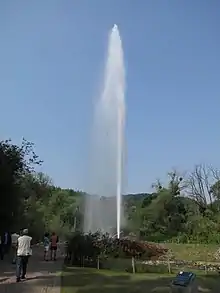Cold-water geyser
Cold-water geysers have eruptions similar to those of hot-water geysers, except that CO
2-bubbles drive the eruption instead of steam from the proximity to magma. In cold-water geysers, CO
2-laden water lies in a confined aquifer, in which water and CO
2 are trapped by less permeable overlying strata. This water and CO
2 can escape this strata only in weak regions like faults, joints, or drilled wells. A drilled borehole provides an escape for the pressurized water and CO
2 to reach the surface. The magnitude and frequency of such eruptions depend on various factors such as plumbing depth, CO
2 concentrations, aquifer yield etc. The column of water exerts enough pressure on the gaseous CO
2 so that it remains in the water in small bubbles. When the pressure decreases due to formation of a fissure, the CO
2 bubbles expand. This expansion displaces the water and causes the eruption. Cold-water geysers may look quite similar to their steam-driven counterparts; however, often CO
2-laden water is more white and frothy.[1] The best known of these are probably Saratoga Springs, New York, or Crystal Geyser, near Green River, Utah.[2] There are also three cold-water geysers in Germany, named Wallender Born (a.k.a. Brubbel), Wehr Geyser and Andernach Geyser (a.k.a. Namedyer Sprudel); two in Slovakia, one in the village of Herľany and a very small one in Sivá Brada; and one in Brazil, in the municipality of Caxambu.[3]

Notes
- Glennon, J. Alan "Carbon-Dioxide-Driven, Cold-Water Geysers" Archived 2009-04-23 at the Wayback Machine Retrieved on 2008-04-01
- Glennon, J.A. 2005; Glennon, J.A. and Pfaff, R.M. 2005
- Bonotto, Daniel Marcos (2016). "Hydrogeochemical study of spas groundwaters from southeast Brazil". Journal of Geochemical Exploration. Elsevier BV. 169: 60–72. doi:10.1016/j.gexplo.2016.07.016. hdl:11449/173240.CS1 maint: ref=harv (link)
See also
References
- Glennon, J.A. (2005). Carbon Dioxide-Driven, Cold Water Geysers, University of California, Santa Barbara. Originally posted February 12, 2004, last update 6 May 2005. Accessed 8 June 2007.
- Glennon, J.A., Pfaff, R.M. (2005). The operation and geography of carbon-dioxide-driven, cold-water geysers, GOSA Transactions, vol. 9, pp. 184–192.